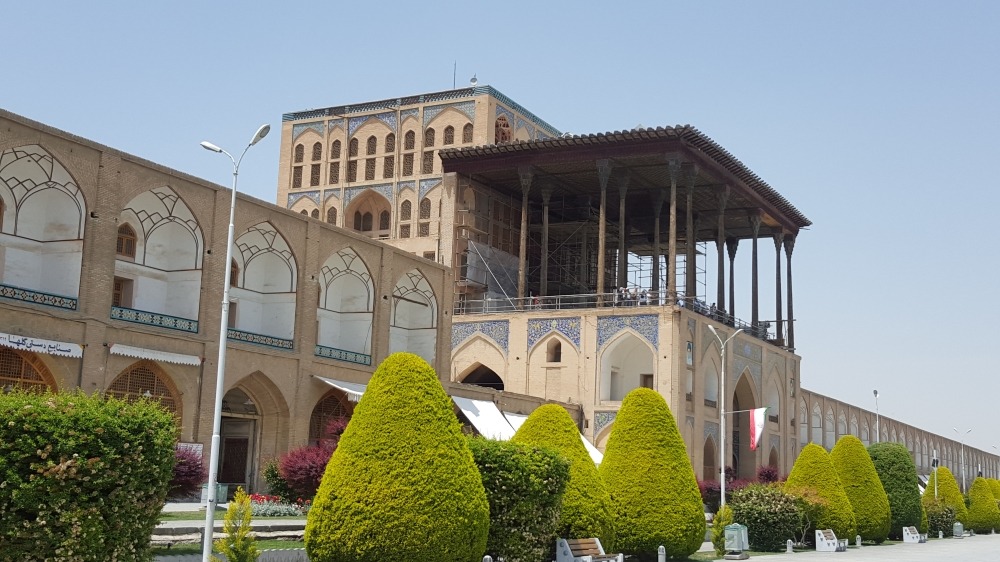Isfahan
Isfahan also called Esfahan or Isphahan, is one of the historical ancient cities located in central Iran plateau and one of the most important Iran destinations. It is not exaggerated when they call Isfahan “a half of the world” by having many masterpiece architectures and monuments, splendid palaces, historical bridges, and being the main center for handicrafts and art. The men mostly were craftsmen and artisans and ladies were carpet weavers. The remaining works of different periods and dynasties indicate the importance of art in Isfahan over the ancient time. the rich

culture, customs and traditions add to its importance. There are two main factors which influenced the economic development of Isfahan. First it was Zayandehrood river, one of the largest rivers by volume in Iran in the past and second its geographical location. Isfahan was on the trade road between Damascus and Halab (Syria) in west and Samarkand and Bokhara (Uzbekistan) in east.
If you wish to travel to Iran, make sure you will visit Iran destinations including Isfahan. Isfahan with more historical sites comparing to other cities is on top of the list of cultural tour in Iran.
Topography
Isfahan is situated in the centre of Iran close to the Central Desert or Dasht-e Kavir and 1590m above sea level on the east of Zagros mountains.
Isfahan Climates
Isfahan is located in the plain 1500m above sea level and between Zagros mountain ranges and central desert alongside Zayandehrood river; however, it has a 4 seasons’ climate. According to world data, Isfahan is one of the coldest regions in Iran. In winter, its climate is cold, dry and desert. It is hot and arid during summer despite its high altitude.
Naghsh-e Jahan Square is one of the most beautiful and fantastic masterpieces which was built by Shah Abbass the Great in the early of 17th century. It is surrounded by outstanding architectural buildings on all sides which are the best evidence of social life in Iran during Safavid dynasty; the royal mosque known as Shah mosque (Imam mosque), Sheikh Lotfollah mosque, the fantastic portico of Qayssariyyeh and Ali Qapu palace of 15th century. Naghsh-e Jahan Square is inscribed in UNESCO World Heritage Site in 1979.
Ali Qapu is a grand palace located in the west part of Naghsh-e Jahan Sq. in Isfahan. It was built in Shah Abbas I from Safavid era. Ali Qapu is forty-eight meters high and contains six floors. The interior walls have been painted with birds, animals and floral motifs by Reza Abbasi, the court painter of Shah Abbas I. Ali Qapu was used for entertaining the noble visitors and foreign ambassadors.
Sheikh Lotfollah Mosque is one the magnificent architectural examples from Safavid dynasty, during Shah Abbass the Great. It is standing on the east side of Naghsh-e Jahan Square in Isfahan. It is dedicated to Sheikh Lotfollah, a reverend Lebanese scholar. This is the only mosque in Iran which has no and courtyard. The composition of cream, blue and turquoise colored tiles, motifs and floral designs of the cupola and the muqarnas of the portal make it a significant masterpiece in the world. When the sun is in the middle of the sky, the reflection of sun beam through the narrow whole on the center of cupola creates the image of a peacock on the inner side of the dome.
Atigh Jameh mosque, the UNESCO World Heritage Site, is one of the most ancient and the unique religious buildings of Iran destinations. It is said that is the first mosque exists in Iran. According to archeological discoveries, containing a pillar bottom, it was a fire temple in Sassanid era, although the exact date of foundation is not clear but estimated to date back to 2000 years ago.
Allahverdi Khan bridge known as Si-o-se pol is the longest bridge on the Zayanderud river; the largest river of Iran. Si-o-se pol is a bridge contains 33 spans. This is why it is called Si-o-se pol which means thirty tree spans. It is one of the outstanding examples of Iran’s architecture in the Safavid dynasty. Si-o-se pol was constructed on early of 17th century by the order of Shah Abbass I and under the supervision of Allahverdi Khan, the Georgian commander-in-chief of the armies. So the bridge called after him. The function of the bridge was to make connections between the mansions of the elite and also linking to the city’s Armenian.
Menar jonban or shaking minarets is one of the amazing architectural attractions in Isfahan, an old monument consists of a porch and 2 minarets made of brick in which when you shake one minaret, the other one will shake too. This happens because of the ratio between the height and width of the minarets and the width of the porch. The wooden beams used in the upper part of the minarets facilitate the shaking of the minarets.
At first, Menar Jonban was only a porch which probably was built around 1316 during the Ilkhanate dynasty as a shrine for Sufis and one of the hermits has been buried here. It seems the minarets were constructed later in the Safavid dynasty.
Vank Cathedral also known as the church of Saintly Sisters is another architectural masterpiece of Iran cultural attractions located in Isfahan. “VANK” is an Armenian word that means monastery. Vank Cathedral was constructed by thousands of Armenian in 1606 who were forcibly resettled there by order of Shah Abbass I and completed between 1655 and 1664 under supervision of Archbishop David. The architecture of the Cathedral is a combination of Iranian and Armenian styles. The Cathedral contains a sanctuary with a domed roof like Iranian mosques and a magnificent semi-octagonal apse exactly like what have seen in western churches. The interior has been decorated and designed by many delicate frescos and gilded carvings. The blue and golden paintings on central dome depicts the story of God and expulsion of Adam from Eden which is according to Bible. There are some murals around the interior walls in two sections which the upper section depicts the events from the life of Jesus while the lower section depicts the tortures made by Ottoman Empire to Armenian martyrs. On top of the entrance there are beautiful floral motifs in Persian miniature style.
